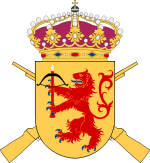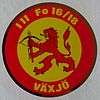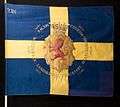Kronoberg Regiment
| Kronoberg Regiment | |
|---|---|
| Kronobergs regemente | |
 | |
| Active | 1623–1709, 1709–1997 |
| Country |
|
| Allegiance | Swedish Armed Forces |
| Branch | Swedish Army |
| Type | Infantry regiment |
| Size | Regiment |
| Part of |
2nd Military District (1833–1893) 2nd Army Division (1893–1901) II Army Division (1902–1927) Southern Army Division (1928–1936) I Army Division (1937–1943) I Military Area (1943–1966) Southern Military Area (1966-1997) |
| Garrison/HQ | Växjö |
| Colors | Red and yellow |
| March | "Admiral Stosch" (Latann)[note 1] |
| Anniversaries | 6 June, 6 November, 11 November |
| Battle honours | Breitenfeld (1631), Lützen (1632), Wittstock (1636), Landskrona (1677), Kliszow (1702), Warszawa (1705), Fraustadt (1706), Holovczyn (1708), Hälsingborg (1710), Valkeala (1790) |
| Insignia | |
| Unit insignia m/1960 |
.jpg) |
| Shoulder sleeve insignia |
 |
The Kronoberg Regiment (Swedish: Kronobergs regemente), designations I 11 and I 11/Fo 16, was a Swedish Army infantry regiment that traced its origins back to the 16th century. It was disbanded in 1997. The regiment's soldiers were originally recruited from Kronoberg County, and it was later garrisoned there.
History
The regiment has its origins in fänikor (companies) raised in Kronoberg County in the 16th century. In 1616, these units—along with fänikor from the nearby Kalmar County—were organised by Gustav II Adolf into Smålands storregemente, of which twelve of the total 24 companies were recruited in Kronoberg County. Smålands storregemente consisted of three field regiments, of which Kronoberg Regiment was one. Sometime around 1623, the grand regiment was permanently split into three smaller regiments, of which Kronoberg Regiment was one.
Kronoberg Regiment was one of the original 20 Swedish infantry regiments mentioned in the Swedish constitution of 1634, although it was mentioned as one of two regiments that should merge to form Småland Regiment, but that regiment was never formed and instead Kronoberg Regiment and Jönköping Regiment were kept separate. The regiment's first commander was Patrick Ruthwen. The regiment was allotted in 1684. The regiment was given the designation I 11 (11th Infantry Regiment) in a general order in 1816.
Kronoberg Regiment was garrisoned in Växjö from 1920. In 1974, the regiment gained the new designation I 11/Fo 16 as a consequence of a merge with the local defence area Fo 16. The regiment was disbanded in 1997.
Heraldry and traditions
The regiment has carried a number of different colour over the years. The last colour was presented to the regiment in Växjö by the Chief of the Army, lieutenant general, count Carl August Ehrensvärd on 6 June 1956.[2] The new colour replaced the one from 1893.[3] The new colour was used as regimental colour by I 11/Fo 16 until 1 September 1997. The colour is drawn by Brita Grep and embroidered by hand in insertion technique by Libraria. Blazon: "On yellow cloth the provincial badge of Småland; a red lion rampant with blue arms, in the forepaws a red crossbow with white arrowhead and black bow, string and trigger. On a red border at the upper side of the colour, battle honours (Breitenfeld 1631, Lützen 1632, Wittstock 1636, Landskrona 1677, Kliszow 1702, Warszawa 1705, Fraustadt 1706, Holovczyn 1708, Hälsingborg 1710, Valkeala 1790) in yellow".[2]
In connection with the disbandment of the regiment through the Defence Act of 1996, its traditions came from 1 December 1998 onwards to be continued by Kronoberg Group (Kronobergsgruppen).[3] From 1 July 2013, the Kronoberg Battalion, within Kalmar and Kronoberg Group (Kalmar- och Kronobergsgruppen) is the traditional keeper of Kronoberg Regiment.[4]
In 1971, the Kronobergs regementes hedersmedalj ("Kronoberg Regiment Honorary Medal") in gold/silver/bronze (KronobregGM/SM/BM) of the 8th size was established. The ribbon is split in yellow, red and yellow.[5][6][7] In 1997, the Kronobergs regementes minnesmedalj ("Kronoberg Regiment Commemorative Medal") in silver (KronobregMSM) was established.[8]
 Colour model 1886-1892 of the 2nd Battalion, Kronoberg Regiment.
Colour model 1886-1892 of the 2nd Battalion, Kronoberg Regiment. 1956 table colour of Kronoberg Regiment.
1956 table colour of Kronoberg Regiment. Kronoberg Regiment Honorary Medal.
Kronoberg Regiment Honorary Medal. Kronoberg Regiment Commemorative Medal.
Kronoberg Regiment Commemorative Medal. Ribbon of the Kronoberg Regiment Commemorative Medal.
Ribbon of the Kronoberg Regiment Commemorative Medal.
Campaigns
- The War against Sigismund (1598–1599)[note 2]
- The Polish War (1600–1629)
- The Thirty Years' War (1630–1648)
- The Torstenson War (1643–1645)
- The Northern Wars (1655–1661)
- The Scanian War (1674–1679)
- The Great Northern War (1700–1721)
- The Seven Years' War (1757–1762)
- The Gustav III's Russian War (1788–1790)
- The First War against Napoleon (1805–1810)
- The Finnish War (1808–1809)
- The Second War against Napoleon (1813–1814)
Organisation
|
|
Commanding officers
Regimental commanders active at the regiment during the years 1627–1997.[9]
- 1627–1630: Patrik Ruthwens
- 1630–1638: Hans Drake
- 1638–1641: Adolf Hård
- 1641–1654: Georg Fleetwood
- 1654–1657: Adolf Herman Wrangel
- 1657–1665: Bertil Nilson Skytte
- 1665–1677: Henrik von Vicken
- 1677–1696: Georg Anthony Brakel
- 1696–1703: Gustaf Heidenfeldt
- 1703–1706: Gabriel Lilliehöök †
- 1706–1709: Johan Cronman (POW)
- 1709–1714: Carl Hästesko (acting)
- 1714–1717: Sven Lagerberg
- 1718–1746: Eberhard Bildstein
- 1722–1727: Johan Cronman
- 1747–1746: Eberhard Bildstein
- 1746–1765: Berndt Wilhelm von Liewen
- 1765–1772: Pehr Scheffer
- 1772–1777: Otto Wilhelm von Rosen
- 1777–1782: Salomon Hederstjerna
- 1782–1812: Carl Axel Strömfelt
- 1812–1816: Elof Rosenblad
- 1816–1824: Erland Hederstjerna
- 1824–1856: Carl Henrik Wrede
- 1856–1862: Georg Miles Fleetwood
- 1862–1873: Gustaf Reinhold Weidenhielm
- 1873–1878: Otto Samuel Gustaf von Klint
- 1878–1889: Klas Hjalmar Kreüger
- 1889–1898: Henrik Esaias Anton Carl Rappe
- 1898–1905: Johan Gustaf Wikander
- 1905–1920: Gösta Hyltén-Cavallius
- 1920–1924: Gustaf Ros
- 1924–1928: Erik Nordenskjöld
- 1928–1932: Erik Grafström
- 1932–1937: Per Erlandsson
- 1937–1941: Gösta Hahr
- 1941–1946: Sven Allstrin
- 1946–1950: Gustaf Källner
- 1950–1957: Carl von Horn
- 1957–1967: Thor Cavallin
- 1967–1972: Lennart Löfgrén
- 1972–1974: Per-Hugo Winberg
- 1974–1977: Bertil Malgerud
- 1977–1980: Per-Hugo Winberg
- 1980–1983: Sven Skeppstedt
- 1983–1988: Finn Werner
- 1988–1989: Björn Swärdenheim
- 1989–1992: Leif Fransson
- 1993–1993: Inge Lennart Sandahl (acting)
- 1993–1997: Jan Henrik Edvard Hyltén-Cavallius
Name, designation and garrison
| Name | Translation | From | To | |
|---|---|---|---|---|
| Kronobergs regemente | Kronoberg Regiment | 1623 | – | 30 June 1997 |
| Designation | From | To | |
|---|---|---|---|
| I 11 | 1816 | – | 30 June 1974 |
| I 11/Fo 16 | 1 July 1974 | – | 30 June 1997 |
| Training ground or garrison town | From | To | |
|---|---|---|---|
| Växjö | – | 1778 | |
| Kronobergshed | 1778 | – | 1920 |
| Gävle (G) | 1920 | – | 30 June 1997 |
See also
Footnotes
References
Notes
- ↑ Sandberg 2007, p. 45
- 1 2 Braunstein 2004, p. 77
- 1 2 Braunstein 2003, pp. 51–54
- ↑ "Försvarets traditioner i framtiden – Bilaga 3" (PDF) (in Swedish). Statens försvarshistoriska museer/Försvarets traditionsnämnd. 2012-07-01. p. 1. Retrieved 12 June 2018.
- ↑ "KronobregGM". www.medalj.nu (in Swedish). Retrieved 12 June 2018.
- ↑ "KronobregSM". www.medalj.nu (in Swedish). Retrieved 12 June 2018.
- ↑ "KronobregBM". www.medalj.nu (in Swedish). Retrieved 12 June 2018.
- ↑ "KronobregMSM". www.medalj.nu (in Swedish). Retrieved 12 June 2018.
- ↑ Kjellander 2003, pp. 276-277
- Braunstein, Christian (2003). Sveriges arméförband under 1900-talet. Skrift / Statens försvarshistoriska museer, 1101-7023 ; 5 (in Swedish). Stockholm: Statens försvarshistoriska museer. ISBN 91-971584-4-5. LIBRIS 8902928.
- Braunstein, Christian (2004). Svenska försvarsmaktens fälttecken efter millennieskiftet [The flags and standards of the Swedish armed forces after the turn of the millennium] (PDF). Skrift / Statens försvarshistoriska museer, 1101-7023 ; 7 [dvs 8] (in Swedish). Stockholm: Statens försvarshistoriska museer. ISBN 91-971584-7-X. LIBRIS 9815350.
- Kjellander, Rune (2003). Sveriges regementschefer 1700-2000: chefsbiografier och förbandsöversikter (in Swedish). Stockholm: Probus. ISBN 91-87184-74-5. LIBRIS 8981272.
- Sandberg, Bo (2007). Försvarets marscher och signaler förr och nu: marscher antagna av svenska militära förband, skolor och staber samt igenkännings-, tjänstgörings- och exercissignaler (in Swedish) (New ed.). Stockholm: Militärmusiksamfundet med Svenskt marscharkiv. ISBN 978-91-631-8699-8. LIBRIS 10413065.
Further reading
| Wikimedia Commons has media related to Kronoberg Regiment. |
- Andrae, Anders J. (1980). Historik över officersmässen vid Kungl. Kronobergs regemente (in Swedish). Växjö: Regementet. LIBRIS 378379.
- Kronobergs regemente - dess människor och deras minnen 1919-1992 (in Swedish). Växjö: Regementet. 1992. LIBRIS 1431869.
- Björck, Rolf, ed. (1996). Kronobergs regemente under 1900-talet (in Swedish). Växjö: Kronobergs regementes historiekomm. LIBRIS 2275928.
- Kungl. Kronobergs regemente: en redogörelse tillägnad regementets personal (in Swedish). Åseda. 1943. LIBRIS 2752303.
- Kungl. Kronobergs regemente och indelningsverket (in Swedish). Växjö: Kronobergs regementes kamratförening. 1973. LIBRIS 798115.
- Kungl. Kronobergs regemente under fyra sekel: 1623-1964 (in Swedish). Växjö. 1967. LIBRIS 798114.
- Mankell, Julius (1866). Anteckningar rörande svenska regementernas historia (in Swedish) (2nd ed.). Örebro: Lindh. pp. 260–269. LIBRIS 1549756.
- Wernstedt, Folke (1923). Kungl. Kronobergs regemente 1623-1923: minnesskrift (in Swedish). Växjö. LIBRIS 1484308.